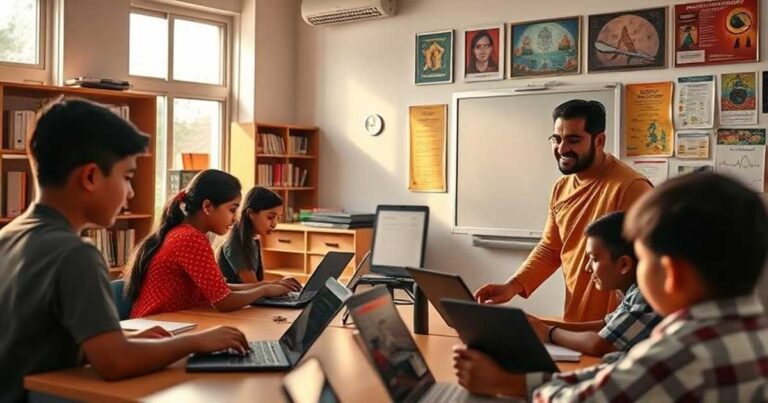Explore how India’s National Education Policy (NEP) integrates technology to transform learning, boost digital literacy, and reduce educational inequality across the nation.
In today’s rapidly evolving digital world, education is no longer confined to chalkboards and textbooks. India’s National Education Policy (NEP) 2020 envisions a system where technology is at the heart of teaching, learning, administration, and evaluation. But how effective has this digital integration been so far? Let’s explore.
NEP 2020: A Digital Vision for Indian Education
The NEP 2020 focuses on equity, accessibility, and quality — and technology is seen as a key enabler for achieving these goals. The policy outlines several tech-based initiatives:
- Virtual Labs & Classrooms
- AI-based Adaptive Learning Platforms
- Digital University Concept
- National Educational Technology Forum (NETF)
- Use of EdTech for Multilingual Content Delivery
Real-World Implementation: Successes So Far
- Digital Infrastructure in Schools (DISHA):
Many public schools have been equipped with smart classrooms, projectors, and high-speed internet, especially in urban areas. - DIKSHA Platform:
The government’s flagship platform has become a massive content hub with free video lessons, e-books, and interactive exercises in multiple languages. - SWAYAM & NPTEL:
These platforms are offering online courses from top institutions like IITs and IIMs, accessible to anyone with internet access.
Challenges in Implementation
Despite its noble intentions, the policy’s tech integration faces several roadblocks:
- Digital Divide:
Rural and remote regions still suffer from poor connectivity and lack of digital devices. - Teacher Training Gaps:
Many educators are not adequately trained to use EdTech tools effectively. - Language Barriers:
Digital content is not always available in regional languages or dialects. - Screen Time Issues:
Over-dependence on screens has raised concerns about mental and physical health in children.
Impact on Students and Learning
- Positive Outcomes:
Interactive and personalized content has made learning more engaging, especially for students with different learning styles. - Increased Access:
Girls and children from marginalized communities now have better access to learning resources through mobile phones. - Career Readiness:
Exposure to digital tools from a young age is helping students build 21st-century skills like coding, problem-solving, and digital literacy.
Expert Insights
According to a report by UNESCO, India’s approach to integrating EdTech through NEP is a model for developing nations, but sustainable infrastructure and local adaptation remain key to its success.
Conclusion
India’s NEP 2020 has laid a strong foundation for the digital transformation of its education system. While challenges persist, the strategic use of technology is already reshaping how India teaches and learns. For lasting impact, continuous investment in digital infrastructure, teacher training, and inclusive policies will be crucial.
Frequently Asked Questions
What role does technology play in the National Education Policy (NEP) of India?
Technology plays a crucial role in NEP 2020 by promoting digital learning, personalized education, online teacher training, and the development of virtual labs and e-content to enhance accessibility and quality in education.
How has NEP 2020 improved access to education using technology?
NEP has enabled wider access through platforms like DIKSHA, SWAYAM, and e-pathshala, providing free online resources, video lectures, and study materials to students across India, especially in remote areas.
Are there any challenges in implementing technology in Indian education under NEP?
Yes, challenges include the digital divide, lack of internet connectivity in rural areas, insufficient digital literacy among teachers, and budget constraints for infrastructure development.
How effective are online teacher training programs introduced in NEP?
Online training under NEP has proven effective in upskilling teachers by offering flexible, scalable, and standardized courses, especially through the NISHTHA platform and similar digital modules.
Does NEP 2020 encourage the use of AI and emerging technologies in education?
Yes, NEP encourages the integration of AI, machine learning, coding, and data science in the curriculum to prepare students for the 21st-century workforce.
What technological platforms are used under NEP 2020 to enhance learning?
Major platforms include DIKSHA (Digital Infrastructure for Knowledge Sharing), SWAYAM (online courses), NISHTHA (teacher training), ePathshala (e-books), and Virtual Labs by MHRD.
How does NEP 2020 support multilingual education using technology?
NEP promotes multilingual content delivery through AI-based translation tools and digital platforms, enabling students to learn in their mother tongue or regional languages.
Can technology help reduce the urban-rural education gap in India under NEP?
Yes, by providing low-cost digital resources and internet-enabled educational services, NEP aims to bridge the urban-rural divide and promote equitable education opportunities.
How does NEP ensure cybersecurity and data privacy for students?
While NEP emphasizes digital adoption, it also highlights the importance of safe technology usage, recommending strict data privacy protocols and digital safety training for all users.
What is the future of technology integration in education as per NEP 2020?
The future is focused on blended learning, personalized AI-driven tools, expanded access to online education, and continuous teacher training to ensure a technologically empowered education ecosystem.
